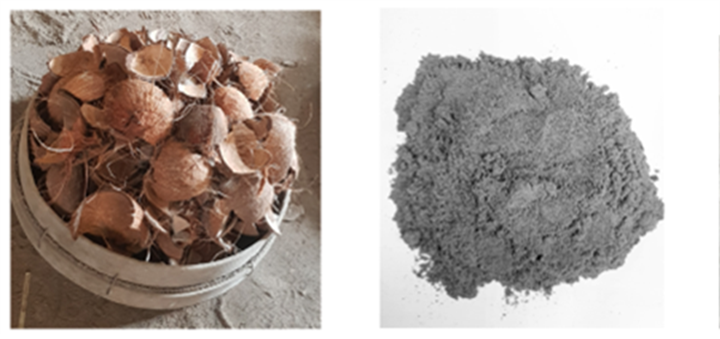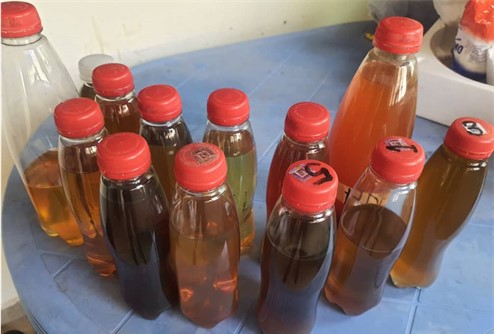Globally, a staggering 8 million tons of plastic waste enter our oceans annually, and projections indicate that by 2050, the volume will exceed the fish population which is estimated to be approximately 3.5 trillion. Ghana contributes around 840,000 tons with less than 10% collected for recycling, according to a 2023 report of the World Economic Forum. Clearly there is a waste problem in Ghana and beyond.
Take the waste problem in Ghana generated from the consumption of fresh coconuts. Although there are many health benefits to coconut, this increased consumption has also led to a corresponding surge in coconut waste, primarily in husks. This raises concerns about its disposal as the volume generated far exceeds current waste management capacity. This juxtaposition highlights the urgent need for sustainable solutions to address the environmental impact of this booming industry.
The Waste Problem in Ghana: An Untapped Resource
The concept of “waste as a resource” has gained traction recently, with prominent organisations and thought leaders advocating for the economic and environmental benefits of repurposing waste materials. An example is the establishment of the Accra Compost and Recycling Plant (ACaRP) which is the first state-of-the-art waste sorting and composting facility in West Africa, as part of efforts to manage solid waste in Accra, and utilize the “waste” to produce industrial materials such as organic compost, palletized plastics, and baled cardboards.
In line with this, the World Economic Forum has emphasised that “waste is not just an environmental burden but a valuable resource” that can drive economic growth through innovative recycling and upcycling practices. Similarly, the Ellen MacArthur Foundation highlights that transitioning to a circular economy, where waste is reintegrated into production cycles, could generate $4.5 trillion in economic benefits by 2030.
How Research Solves The Waste Problem In Ghana
The role of academic institutions, particularly through research and development (R&D), is pivotal in addressing the waste problem in Ghana. In this regard, some researchers from the University of Mines and Technology are converting coconut shells and plastics into useful industrial materials such as Asbestos-Free Brake Pads and Liquid Fuels respectively, as discussed below:
- Development of Asbestos-Free Disc Brake Pad using Coconut Shell Ash as base material by Dr Emmanuel Seckley, Prof Anthony Simons, and Prof Akintunde O. Dahunsi
Brake pads are a crucial component of an automobile braking system, playing a vital role in maintaining full control of the vehicle. Chrysotile asbestos fibre, once popular in the past as a brake pad material, for its sound absorption, strength, and flexibility, became a health concern in the 1970s due to its carcinogenic properties and disposal issues. Many countries subsequently banned its use in friction materials, leading to extensive research on safer asbestos-free brake pads.
This shift has resulted in various brake pad compositions in recent years. Alternative raw materials like industrial and agricultural waste have gained attention as replacements for asbestos. Researchers worldwide have explored non-hazardous materials like palm kernel shells and fiber, rice husk, maize husk, coconut shells, and bamboo fiber among others for brake pad production.

Coconut Shells and Coconut Shell Ash
Despite Ghana’s abundance of materials for asbestos-free brake pad production, there is a lack of comprehensive research to identify the most suitable materials for manufacturing brake pads for the local market. Currently, many unknown aftermarket replacement brake pads flood the Ghanaian market, lacking clear specifications, and falling short of the quality standards set by well-known suppliers like Toyota, Nissan, Mercedes, Honda, and others.
To address these issues, this research saw the leveraging of locally available materials to develop and manufacture eco-friendly, high-quality brake pads for commercial use. This initiative aims to reduce the cost of importing such products and create a sustainable local industry. The development and adoption of this new asbestos-free brake pad will not only enhance safety and address environmental concerns but also create opportunities for local businesses to thrive and contribute to the country’s economy.

Produced brake pads
Comparing the properties of the developed brake pad to commercial and asbestos-based brake pads
According to the researchers, the brake pad was compared favorably in various aspects with an asbestos-based brake pad and two after-market replacement commercial brake pads that were tested. It exhibits higher water absorption values compared to both the commercial and asbestos-based brake pads and outperforms the two commercial brake pads in oil absorption. Additionally, the developed brake pad demonstrates higher compressive and hardness values than both the commercial and asbestos-based pads. Its coefficient of friction aligns closely with the two commercial brake pads and falls within the typical friction range of the asbestos-based brake pad (0.3 – 0.6). Furthermore, the average wear value of the produced pad is competitive, slightly outperforming the commercial brake pads and trailing the asbestos-based pad by only 4.04 %.
- Production of Liquid Fuels from End-of-Life-Plastics by Prof James Ransford Dankwah
According to the minerals and solid waste management and processing engineer, less than 5% of end-of-life plastics are recycled in Ghana.

Samples of waste plastics used for the production
In 2020, Ghana’s total energy consumption amounted to 8,654 tons of which Petroleum was the most consumed energy product, as it amounted to roughly half the total energy consumption. Again in a February 1st, 2022 news by the Vaught, petroleum imports rose by 48.83%, dragging total imports to new highs. “With the rise in consumption fueling growing demand for imports of petroleum products- which has implications on the country’s currency- this may come at a huge cost to the country”, says Fitch.
The production process involved the thermal decomposition of the end-of-life plastics into gaseous high molecular weight monomers, followed by catalytic cracking and condensation of the resulting gaseous species into the required liquid fuels like petrol, diesel, aviation fuel, and/or kerosene using suitable catalysts. The type of liquid fuel produced however depends on the type and amount of catalyst loaded to the catalytic chamber.

Samples of the liquid fuels produced from plastics
The refreshing news is that the Fourier Transform Infrared Spectroscopy (FTIR), Gas Chromatography-Mass Spectrometry (GC-MS), and other petrochemical analyses of the fuels produced compares favorably to the standard fuels sold on the Ghanaian market by Oil Marketing Companies.
Socioeconomic Impact
The aforementioned research projects align with the Sustainable Development Goals and can stimulate local economies by supporting agriculture and manufacturing (SDG 8: Decent Work and Economic Growth), reducing environmental pollution (SDG 13: Climate Action), and promoting responsible consumption and production (SDG 12: Responsible Consumption and Production). Additionally, reducing reliance on harmful materials and fostering new industries contribute to good health and well-being (SDG 3) and industry, innovation, and infrastructure (SDG 9).
In addition, realising the full potential of these projects will require substantial investment, hence a call for investments by both the public and private sectors.
